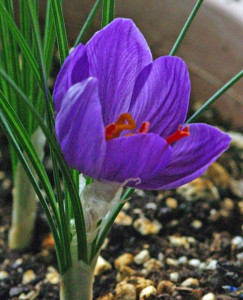Crocus sativus, commonly known as saffron crocus, or autumn crocus, is a species of flowering plant of the Crocus genus in the Iridaceae family. It is best known for the spice saffron, which is produced from parts of the flowers.
Contents
Uses
Crocus sativus is used for asthma, cough, whooping cough (pertussis), and to loosen phlegm (as an expectorant). It is also used for sleep problems (insomnia), cancer, “hardening of the arteries” (atherosclerosis), intestinal gas (flatulence), depression, Alzheimer’s disease, fright, shock, spitting up blood (hemoptysis), pain, heartburn, and dry skin.
Women use Crocus sativus for menstrual cramps and premenstrual syndrome (PMS). Men use it to prevent early orgasm (premature ejaculation) and infertility.
Crocus sativus is also used for to increase interest in sex (as an aphrodisiac) and to induce sweating.
Some people apply Crocus sativus directly to the scalp for baldness (alopecia).
In foods, Crocus sativus is used as a spice, yellow food coloring, and as a flavoring agent.
In manufacturing, Crocus sativus extracts are used as fragrance in perfumes and as a dye for cloth.
Benefits
- Crocus sativus contains several plant-derived chemical compounds that are known to have been anti-oxidant, disease preventing, and health promoting properties.
- Their flower pistils compose several essential volatile oils, but the most important of them all is safranal which gives Crocus sativus its pleasant flavor. Other volatile oils in saffron are cineole, phenethenol, pinene, borneol, geraniol, limonene, p-cymene, linalool, terpinen-4-oil, etc.
- This colorful spice has many non-volatile active components; the most important of them is a-crocin, a carotenoid compound, which gives pistils their characteristic golden-yellow color. It also contains other carotenoids, includingzea-xanthin, lycopene, a- and ß-carotenes. These are important antioxidants that help protect the human body from oxidant-induced stress, cancers, infections and acts as immune modulators.
- The active components in Crocus sativus have many therapeutic applications in many traditional medicines as antiseptic, antidepressant, anti-oxidant, digestive, anti-convulsant.
- This novel spice is a good source of minerals like copper, potassium, calcium, manganese, iron, selenium, zinc and magnesium. Potassium is an important component of cell and body fluids that helps control heart rate and blood pressure. Manganese and copper are used by the human body as co-factors for the antioxidant enzyme,superoxide dismutase. Iron is essential for red blood cell production and as a co-factor for cytochrome oxidasesenzymes.
- Additionally, it is also rich in many vital vitamins, including vitamin A, folic acid, riboflavin, niacin, vitamin-C that is essential for optimum health.
Caution
Crocus sativus is POSSIBLY SAFE for most people when taken by mouth as a medicine for up to 6 weeks. Some possible side effects include dry mouth, anxiety, dizziness, drowsiness, nausea, change in appetite, and headache. Allergic reactions can occur in some people.
Taking large amounts of Crocus sativus by mouth is POSSIBLY UNSAFE. High doses can cause poisoning, including yellow appearance of the skin, eyes, and mucous membranes; vomiting; dizziness; bloody diarrhea; bleeding from the nose, lips, and eyelids; numbness; and other serious side effects. Doses of 12-20 grams can cause death.
Interactions
None are recorded.
Other names
Autumn Crocus, Azafrán, Azafron, Croci Stigma, Crocus Cultivé, Indian Saffron, Kashmira, Kesar, Kumkuma, Saffron Crocus, Safran, Safran Cultivé, Safran Espagnol, Safran des Indes, Safran Véritable, Spanish Saffron, True Saffron, Zafran
Reference
Source: Nutrition-and-you, http://www.nutrition-and-you.com/saffron.html
Wikipedia, https://en.wikipedia.org/wiki/Crocus_sativus
WebMD, http://www.webmd.com/vitamins-supplements/ingredientmono-844-saffron.aspx?activeingredientid=844

